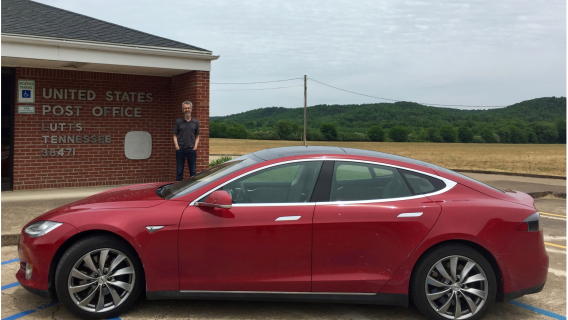It’s Apparently Quite Easy to Crash a Tesla. Investing in Tesla Stock Right Now Seems Harder. It’s Not - Here’s Why.
Last week there was a flurry of interest, once again, in the subject of crashed Teslas, so today I’m providing this handy guide to how you too can crash a Tesla. (Later, I’ll tell you how to invest in Tesla at current prices.)
- First, acquire a Tesla in some way (buy, lease, beg, borrow or steal).
- Drive it onto a highway.
- Engage Autopilot.
- Get out your phone and do whatever you want, for as long as you want.
[text_ad use_post='129622']
Now, this system is not guaranteed to crash the Tesla. In fact, in most cases this system will fail. But if, in fact, you do succeed in crashing a Tesla using my system, you’ll be famous, at least for a while.
But Seriously
I understand the old newspaperman’s axiom, “If it bleeds, it leads.” Tesla crashes make good headlines.
But let’s look at the facts.
The first recorded Tesla Autopilot death occurred in Florida back in May 2016 when the vehicle drove under a semi trailer while the driver was watching a Harry Potter movie on his laptop.
The one in the news last week, thanks to the National Transportation Safety Board (NTSB) report, actually occurred on the morning of Friday, March 23, 2018 in California, when an Apple engineer who was playing the video game Three Kingdoms on his company-issued iPhone crashed into a safety barrier. The report blamed Tesla, Apple and the California Department of Transportation, which had failed to repair the damaged crash attenuator after a crash 11 days before.
And what about the driver? It’s clear to me, as in the Florida crash, that if the driver had simply been paying attention, he’d still be alive today. Instead, he was playing a video game, just as he had done on his drive to work every day that week. A family was broken and Apple lost a good engineer, mainly because cell phones and cars—self-driving or not—don’t mix.
Laws Against Using Handheld Devices While Driving
The fact that handheld devices distract drivers is well known. In fact, just last month Massachusetts joined the other five New England states in banning the use of any handheld device by drivers.
Elsewhere, California, Delaware, Georgia, Hawaii, Illinois, Maryland, Minnesota, Nevada, New Jersey, New Mexico, New York, Oregon, Tennessee, Washington, West Virginia (plus Washington, D.C., Puerto Rico, Guam and the U.S. Virgin Islands) prohibit drivers from using handheld cell phones while driving. Thirty-six states and Washington, D.C. ban all cell phone use by newer drivers, while 19 states and Washington, D.C. prohibit any cell phone use by school bus drivers if children are present.
The only states with no laws prohibiting cell phone use are Idaho, Missouri, and Montana.
Still, people keep using cell phones while they’re driving. So perhaps a technological shut-off mechanism is needed—which somehow detects whether or not someone is in the driver’s seat. As for self-driving cars…
More People Should Use Autopilot—and Other Driver Assistance Features
Admittedly, this is counterintuitive. If people in self-driving Teslas are crashing, why should more people use them? Simply because, without self-driving features, even more cars crash; you just don’t see them on the nightly news.
Tesla’s Vehicle Safety Report for the last quarter of 2019 revealed these facts:
Teslas on Autopilot were involved in one accident for every 3.07 million miles driven.
Teslas without Autopilot but with active safety features had one accident per 2.10 million miles driven.
Teslas with neither Autopilot nor other active safety features were involved in one accident for every 1.64 million miles driven.
By comparison, the National Highway Traffic Safety Administration (NHTSA), looking at all the vehicles in the U.S., calculates that there’s one automobile accident for every 479,000 miles driven. That’s 6.4 times as much as Teslas on Autopilot.
Now, these data sets are not directly comparable. Tesla vehicles, on average, are newer than the average vehicle in the U.S., and their drivers are, on average, better educated and wealthier. And those miles driven on Autopilot are, on average, more likely to be highway miles than city miles.
So, the real advantage provided by Autopilot is almost certainly less than 6x. In fact, it may just be 2x, the difference between Teslas on Autopilot and Teslas with no active safety features.
But 2x is still very good, and if people would put down their cell phones while they’re on Autopilot, I have no doubt it would be even better.
In the meantime, for all the reasons I’ve been writing about for the past nine years, I still believe TSLA stock is worth owning.
How to Invest in Tesla (TSLA)
Tesla came public in June 2010; I first recommended it in Cabot Stock of the Week in December of 2011, when the stock was selling at 30—and I’m still recommending that my readers hold it. Tesla is not done changing the world.
But if I didn’t own Tesla stock now and I wanted to get on board, I’d wait for two things. First is the end of the current market correction; the sellers are currently in power and your odds will be better if you wait until the correction is over. Second is for the stock to come down near its 50-day moving average, which is currently in the 600 region.
How to Invest in the Next Tesla
Alternatively, I’d invest in a fast-growing company that has an exciting new business model that could change the world as much as Tesla has changed the automotive world. The stock I’m talking about came public at the end of 2017. I recommended it to my Cabot Stock of the Week readers in October 2019. And our profit is already 140%.
To learn its name, click here.
[author_ad]

